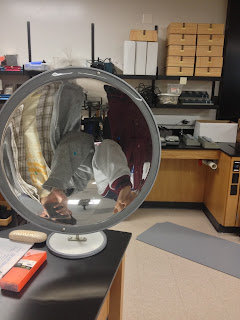ObjectiveUse sound sensor, logger pro, and tuning fork to
study sound waves.
Procedure
Let first person
say "AAAAAAA" into the microphone and collect the data
Let another person do the same thing and record
the data.
Strike the tuning
fork and record the data
Data
First Person
Second Person
Stuck the tuning fork hardly
Struck the tuning
fork softly
Questions1a)
Yes, it is repeating.
b) We observed 4 waves. We determined waves by
group
c) Prob time is 0.03 seconds. It is about a blink of an eye.
d) The
period of the waves is 0.0075 seconds
e) Frequency is 133Hz
f) Lambda
=2.55m. It is about the height of the classroom
g) Amplitude is about 0.6115
(no unit)
h) There would be more waves, but the frequency, lambda, amplitude
will stay the same
test results: there are 38 waves, period become
0.00789, lambda becomes 2.68, Amplitude becomes 0.602
2 18
waves, T=0.00167s, A=0.234, lambda=0.566m
38 waves,
T=0.00375, A=0.0695, lambda=1.275
4We expect to have
the same frequency, wave length, sahpe, but different
amplitudes.
Struck softly

Struck
hardly














































